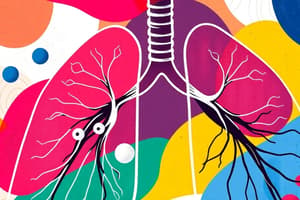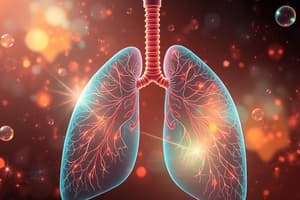Podcast
Questions and Answers
Which of the following drugs is classified as an antihistamine for upper respiratory tract issues?
Which of the following drugs is classified as an antihistamine for upper respiratory tract issues?
- Phenylephrine
- Codeine
- Diphenhydramine (correct)
- Albuterol
What is the first noticeable sign of theophylline toxicity?
What is the first noticeable sign of theophylline toxicity?
- Increased heart rate
- Breathing difficulty
- Tremors
- Nausea (correct)
Which of the following corticosteroids is recommended for treating lower respiratory tract conditions?
Which of the following corticosteroids is recommended for treating lower respiratory tract conditions?
- Montelukast
- Beclomethasone (correct)
- Ambroxol
- Phenylephrine
Which of the following should be emphasized as part of nursing considerations for patients with respiratory issues?
Which of the following should be emphasized as part of nursing considerations for patients with respiratory issues?
What is the expected duration of action for the short-acting sympathomimetic bronchodilator Albuterol?
What is the expected duration of action for the short-acting sympathomimetic bronchodilator Albuterol?
Flashcards are hidden until you start studying
Study Notes
Drugs for Upper Respiratory Tract
- Antihistamines
- Examples: Chlorpheniramine, Diphenhydramine, Claritin, Cetirizine
- Drugs for Common Colds
- Example: Phenylephrine
- Drugs for Cough
- Antitussives: Dextromethorphan, Codeine, Butamire
- Expectorant: Guaifenesin
- Mucolytic: Carbocysteine, Ambroxol, Bromhexine
Drugs for Lower Respiratory Tract
- Bronchodilators
- Xanthine Derivatives (Methylxanthines)
- Example: Aminophylline (Theophylline Thylenediamine)
- Therapeutic Level: 10-20 mcg/ml
- Toxicity:
- Nausea: First sign, occurs at levels greater than 20 mcg/mL
- Tremor: Occurs at levels greater than 35 mcg/mL
- Sympathomimetic Bronchodilators/Beta-2 Agonists
- Short Acting: Albuterol (Duration: ≤ 20 minutes, lasts 4-6 hours)
- Long Acting: Terbutaline (Lasts 12 hours)
- Anticholinergic Bronchodilators:
- Example: Ipratromium Bromide (Inhalation)
- Xanthine Derivatives (Methylxanthines)
- Steroids
- Examples:
- Beclomethasone
- Hydrocortisone
- Prednisone
- Examples:
Nursing Considerations
- Breathing and Coughing Techniques: Help remove secretions and optimize oxygen exchange
- Relaxation Techniques: Use music for relaxation
- Vital Signs: Assess heart rate and blood pressure
- Patient Positioning: Use appropriate positioning for comfort
- Tremors: Observe for tremors, a possible side effect of medications
- Hydration: Encourage 8 or more glasses of fluid to thin secretions
- Smoking Cessation: Emphasize the importance of no smoking
- Steroid Usage:
- Acute Attacks: Do not use steroids for acute attacks.
- Bronchodilator First: Use Bronchodilator before Corticosteroid aerosol.
- Inhale and Hold: Hold inhaled drug for a few seconds before exhaling.
- Time Between Inhalations: Allow 1-3 minutes to elapse between each inhalation
- Rinse Mouth: Rinse mouth with water after using inhaled steroids.
- Sore Throat/Mouth: Notify provider if sore throat or mouth occurs.
- Do Not Stop Abruptly: Do not stop steroids abruptly.
- Taper Off: Taper off gradually under provided supervision.
Anti-Asthma Drugs
- Leukotriene Receptor Antagonist:
- Example: Montelukast
- Mast Cell Stabilizers:
- Example: Cromolyn Sodium
Studying That Suits You
Use AI to generate personalized quizzes and flashcards to suit your learning preferences.




